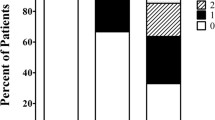Abstract
The objective of the present study is to determine whether benign joint hypermobility syndrome (BJHS) modifies the risk of mitral valve prolapse (MVP) in patients with fibromyalgia (FM). Female patients fulfilling the 1990 American College of Rheumatology (ACR) diagnostic criteria for FM were included into the study. Joint hypermobility and BJHS were assessed using Beighton’s scoring system and Brighton criteria, respectively. Echocardiograpic evaluation was performed in order to test the presence of MVP. Of the 75 female FM patients, 68.0 % (n = 51) and 20.0 % (n = 15) were diagnosed with BJHS and MVP, respectively. The frequencies of both MVP and BJHS seemed higher than the general population prevalence (p = 0.000 for both). The frequency of MVP was significantly higher in patients with BJHS than that in patients without BJHS (p = 0.028). In addition, BJHS was found to increase the risk of MVP approximately ninefold [odds ratio (OR) 8.7, 95 % confidence interval (CI) 1.1–70.7]. As a result, BJHS and MVP are both common in female patients with FM. Moreover, among the female patients with FM, those with BJHS are about nine times more prone to MVP than those without BJHS. Cardiologic assessment might be added to the routine follow-up strategies in FM patients with BJHS in order to exclude the cardiac pathologies, especially MVP.
Similar content being viewed by others
References
Pellegrino MJ, Van Fossen D, Gordon C, Ryan JM, Waylonis GW (1989) Prevalence ofmitral valveprolapse in primaryfibromyalgia: a pilot investigation. Arch PhysMed Rehabil 70:541–543
Jones GT, Atzeni F, Beasley M, Flüß E, Sarzi-Puttini P, Macfarlane GJ (2015) The prevalence of fibromyalgia in the general population: a comparison of the american college of rheumatology 1990, 2010, and modified 2010 classification criteria. Arthritis Rheumatol 67:568–575
Waylonis GW, Heck W (1992) Fibromyalgia syndrome, New associations. Am J Phys Med Rehabil 71:343–348
Ofluoglu D, Gunduz OH, Kul-Panza E, Guven Z (2006) Hypermobility in women with fibromyalgia syndrome. ClinRheumatol 25:291–293
Ofluoglu D, Panza-Kul E, Gunduz OH, Guven Z (2004) The frequency of clinical signs in patients with fibromyalgia syndrome and the relationship between fibromyalgia syndrome and hypermobility. Turk J Phys Med Rehab 50:9–12
Simmonds JV, Keer RJ (2007) Hypermobility and the hypermobility syndrome. Man Ther 12:298–309
Grahame R (2000) Pain, distress and joint hyperlaxity. Joint Bone Spine 67:157–163
Güvenç TS, Canga Y, Karabağ Y, Ozen K, Balcı B (2012) Prevalence of mitral valveprolapse in residentsliving at moderatelyhighaltitude. WildernessEnvironMed 23:300–306
Wolfe F, Smythe HA, Yunus MB, Bennett RM, Bombardier C, Goldenberg DL et al (1990) The American college of rheumatology 1990 criteria for the classification of fibromyalgia. Report of the multicenter criteria committee. Arthritis Rheum 33:160–172
Beighton P, Solomon L, Soskolne CL (1973) Articular mobility in an African population. Ann Rheum Dis 32:413–418
Grahame R, Bird HA, Child A (2000) The revised (Brighton 1998) criteria for the diagnosis of benign joint hypermobility syndrome (BJHS). J Rheumatol Jul 27:1777–1779
Freed LA, Benjamin EJ, Levy D, Larson MG, Evans JC, Fuller DL et al (2002) Mitral valve prolapse in the general population: the benign nature of echocardiographic features in the Framingham Heart Study. J Am CollCardiol 40:1298–1304
ACC/AHA guidelines for the management of patients with valvular heart disease. A report of the American College of Cardiology/American Heart Association. Task Force on Practice Guidelines (Committee on Management of Patients With Valvular Heart Disease (2006) J Am CollCardio l48:1-148.
SendurOF GG, Bozbas GT (2007) The frequency of hypermobility and its relationship with clinical findings of fibromyalgia patients. Clin Rheumatol 26:485–487
Grahame R (2008) Hypermobility: an important but often neglected area within rheumatology. Nat Clin PractRheumatol 4:522–524
Gulpek D, Bayraktar E, Akbay SP, Capaci K, Kayikcioglu M, Aliyev E et al (2004) Joint hypermobility syndrome and mitral valve prolapse in panic disorder. Prog Neuro Psycho Pharmacolbiol Psychiatry 28:969–973
Mishra MB, Ryan P, Atkinson P (1996) Extra-articular features of benign joint hypermobility syndrome. Br J Rheumatol 35:861–866
Devereux RB, Kramer FR, Brown WT (1986) Relation between clinical feature of the mitral valve prolapse syndrome and echocardiographically documented mitral valve prolapse. J Am CollCardiol 8:763–772
Child AH (1986) Joint hypermobility syndrome: inherited disorder of collagen synthesis. J Rheumatol 13:239–243
Pitcher D, Grahame R (1982) Mitral valve prolapse and joint hypermo- bility: evidence for a systemic connective tissue abnormality? Ann Rheum Dis 42:352–354
Arnold LM, Fan J, Russell IJ, Yunus MB, Khan MA, Kushner I et al (2013) The fibromyalgia family study: a genome-wide linkage scan study. Arthritis Rheum 65:1122–1128
Rahman A, Underwood M, Carnes D (2014) Fibromyalgia. BMJ348:g1224.
Hinkes B, Hilgers KF, Bolz HJ, Goppelt-Struebe M, Amann K, Nagl S, et al. (2012) A complex microdeletion 17q12 phenotype in a patient with recurrent de novo membranous nephropathy. BMC Nephrol13:27.
Sanford EF, Bermudez-Wagner K, Jeng LJ, Rauen KA, Slavotinek AM (2011) Congenital diaphragmatic hernia in smith-magenis syndrome: a possible locus at chromosome 17p11.2. Am J Med Genet A 155:2816–2820
Kozma C, Blancato J, Meck J, Jiang Y (1998) Characterization of a supernumerary marker derived from chromosome 17 by microdissection in an adult with MR/MCA. Am J Med Genet 77:19–22
Delling FN, Vasan RS (2014) Epidemiology and pathophysiology of mitral valve prolapse: new insights into disease progression, genetics, and molecular basis. Circulation 129:2158–2170
Hayek E, Gring CN, Griffin BP (2005) Mitral valve prolapse. Lancet 365:507–518
Acknowledgments
We thank Prof. and Dr. Gulsah Seydaoglu who contributed significantly on the statistical analysis of the study.
Conflict of interest
None.
Author information
Authors and Affiliations
Corresponding author
Rights and permissions
About this article
Cite this article
Kozanoglu, E., Coskun Benlidayi, I., Eker Akilli, R. et al. Is there any link between joint hypermobility and mitral valve prolapse in patients with fibromyalgia syndrome?. Clin Rheumatol 35, 1041–1044 (2016). https://doi.org/10.1007/s10067-015-3024-9
Received:
Revised:
Accepted:
Published:
Issue Date:
DOI: https://doi.org/10.1007/s10067-015-3024-9




